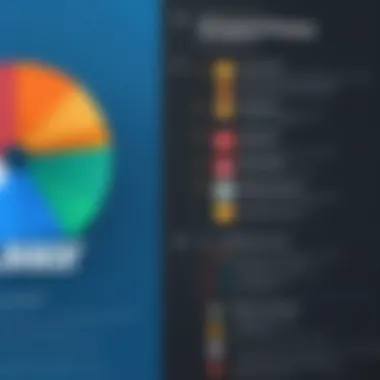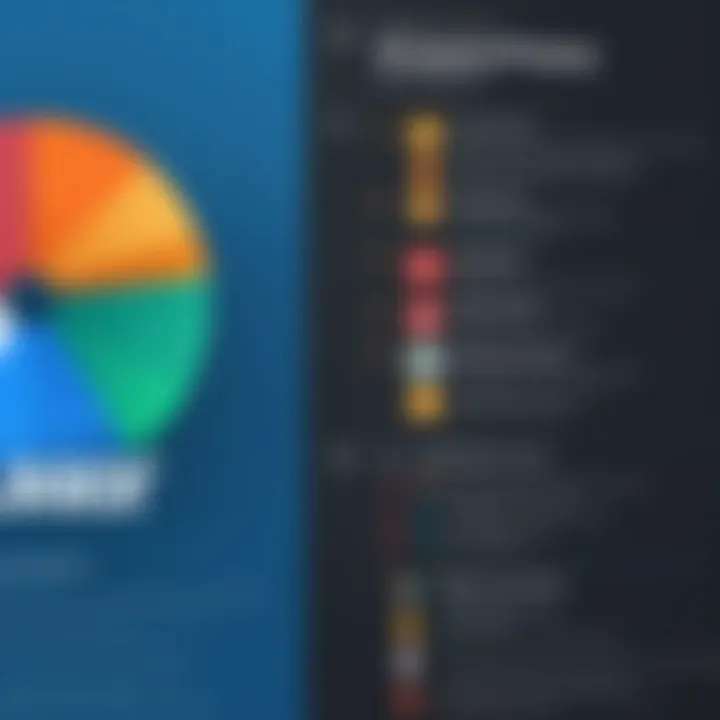A Comprehensive Guide to Deleting Cookies and Cache


Intro
Managing cookies and cache is often overlooked in the realm of web browsing. However, there is a growing impact of such digital remnants on privacy and overall performance. Cookies, though they benefit user experience by remembering login details and preferences, can also pose a risk to privacy if not managed correctly. Cache, on the other hand, temporarily stores images and other web content to enhance loading speed. Over time, they may accumulate and cause slowdowns in performance.
In this guide, we will address why it is essential to periodically delete cookies and cache files. Not only does this process streamline web browsing, but it also plays a significant role in protecting personal information. The emphasis will be on step-by-step instructions to delete these files across various platforms. We will look into misconceptions surrounding cookies and cache management, explore common cybersecurity threats, and highlight effective best practices. Ultimately, our goal is to equip the reader with knowledge that strengthens their online security posture while fostering confidence in their ability to navigate digital spaces.
Cybersecurity Threats and Trends
In today's digital landscape, cyber threats are pervasive and evolving. Individual users and businesses are constantly at risk of breaches that threaten personal data and sensitive information. Understanding these threats can better prepare users to protect themselves.
Notable cybersecurity threats in the digital landscape
Some of the most common threats include:
- Phishing Attacks: Deceptive emails asking for personal data leave individuals vulnerable.
- Malware: Software designed to disrupt or gain unauthorized access to systems, often without the user's consent.
- Ransomware: A type of malware that systematically locks files, demanding ransom for access.
- Man-in-the-middle (MitM) attacks: Unauthorized interception of communications between two parties, leading to information theft.
Emerging trends in cyber attacks and vulnerabilities
As technology advances, so do tactics used by cybercriminals. Current trends worth noting include:
- Increased use of artificial intelligence to automate attacks.
- The Internet of Things (IoT) vulnerabilities, as more devices are connected.
- Social engineering techniques exploiting human behavior instead of system weaknesses.
- Increased sophistication in distributed denial-of-service (DDoS) attacks, overwhelming services to create outages.
Impact of cyber threats on individuals and businesses
Cyber threats can have drastic effects on both personal and business fronts. For individuals, loss of personal data can lead to identity theft, financial loss, and emotional distress. In business, these attacks may result in loss of revenue, damage to reputation, disruptions in operations, and potential legal consequences.
Staying informed and proactive about cybersecurity is paramount. Knowing how to delete cookies and cache from devices is an essential part of a broader strategy of online safety and efficiency.
“Cybersecurity is everyone's responsibility. Awareness is key in preventing breaches.”
In the upcoming sections, we will provide guidance for effectively managing cookies and cache on various devices and platforms, highlighting their significance in maintaining both privacy and performance.
Prolusion to Cookies and Cache
Managing your online presence begins with understanding two fundamental components: cookies and cache. Both elements profoundly influence user experience, performance, and privacy while navigating the web. This section introduces these concepts, offering insights into their functions and importance.
Understanding Cookies
Cookies are small text files that web servers place on your device. Their primary role is to hold data specific to a particular client and website. Cookies can enhance surfing by remembering your preferences, keeping you logged in, and tracking your activities across sessions.
For example, when you visit an e-commerce site, cookies save items in your shopping cart. They allow the website to greet you by name the next time you visit. However, cookies also raise significant privacy concerns. They can track users' habits, creating a profile that many would rather keep private. Knowing how cookies work is the first step toward controlling them.
Understanding Cache
Cache, on the other hand, stores copies of web pages or files to temporarily speed up access. When you revisit a website, the browser can retrieve the cached content instead of downloading it again. This results in faster load times and improved performance.
However, relying too much on cache can become problematic. Websites continuously update content, and an outdated cache may lead to display issues or errors. Understanding the cache helps users mitigate these problems, ensuring a smoother browsing experience.
The Importance of Cookie and Cache Management
Effective management of cookies and cache is essential for multiple reasons. One primary advantage of this management is enhanced security and privacy. Inadequate control can lead to persistent tracking, while frequent clearing of cookies reduces the personal data available for third parties.
In terms of performance, regular maintenance of cache can lead to improvements in speed and functionality. Old cache data may slow down a browser, causing frustration when loading pages. By routinely managing cookies and cache, users can resolve website issues, minimize loading times, and protect their online footprint. Therefore, proactive management of these elements is not only beneficial but essential for those looking to boost overall performance and privacy.
Regularly managing cookies and cache helps improve both online privacy and browser performance.
Reasons for Deleting Cookies and Cache
Deleting cookies and cache plays a vital role in how users interact with websites and applications. This process addresses multiple concerns that enhance the overall browsing experience. Understanding the specific reasons behind the deletion can lead to better management and improved performance. Here, we will explore three primary motivations for managing cookies and cache effectively.
Enhancing Browser Performance
Cookies and cache accumulate over time as you browse the internet. While they are intended to speed up your browsing experience by storing data that websites need, they can, in fact, slow down your browser if left unchecked. When a cache becomes overstuffed, it can lead to longer loading times or even prevent websites from loading at all.
By regularly deleting this stored data, users allow their browsers to free up valuable memory space. This creates room for fresh data and can facilitate quicker access to websites. A lean browser typically handles user requests more efficiently, offers snappier scroll responses and search function speeds, and minimizes lag.


Improving Privacy and Security
One crucial aspect that cannot be ignored is the importance of privacy and security. Cookies often track user activities across the websites they visit. This tracking provides better site experiences, but it also poses a serious risk if that data is mismanaged or exploited by third parties. Unwanted cookies can lead to targeted advertisements, which may increase the risk of phishing attacks or data breaches.
By clearing cookies, an individual can regain control over personal information that may be stored inadvertently. It's also a helpful practice in minimizing risks associated with unauthorized data access. For users concerned about online footprints, regular deletion is a sound strategy. Employing practices such as the disabling of third-party cookies further enhances privacy protections against potential trackers.
Resolving Website Issues
Sometimes, problems develop when browsing, resulting from stale or outdated data. This can manifest as broken elements on a webpage, improper loading or even complete failure to display. Clearing cache and cookies can effectively solve these anomalies. When a website updates but the previously stored cache prevents the new content from loading properly, users may experience unexpected issues.
Deleting cookies and cache can remove these barriers and allow websites to pull alternative, updated content seamlessly. Simple fixes to errors may heavily rely on及时 eliminating old files. This practice can result in much smoother browser interaction and consistent web experiences.
By comprehensively understanding all three of these motivations, users can adopt informed routines for deleting cookies and cache, tailoring their browser settings to ramp up performance and robustness while keeping their engagements secure.
Efficient management ultimately leads to enhanced user experience while preserving seamlessly operational browsers.
How to Delete Cookies and Cache in Chrome
Deleting cookies and cache in Chrome is crucial for maintaining both privacy and performance. Browsing history, cookies, and cache files can accumulate over time, negatively impacting how your browser functions. Regularly clearing this data helps to manage these effects, ensuring a smoother and faster browsing experience. Furthermore, this process can address other concerns, such as unwanted advertisements and tracking by websites.
Accessing Settings
To initiate the deletion process in Chrome, users must first access the settings menu. Follow these steps:
- Open Google Chrome.
- Click on the three vertical dots located in the upper-right corner of the browser window.
- From the dropdown menu, select "Settings."
This pathway leads to the main settings page, where various aspects of Chrome's functionality can be adjusted.
Clearing Browsing Data
Next, the user must clear the browsing data, which encompasses both cookies and cached files. Here’s how:
- In the Settings menu, navigate to Privacy and Security.
- Click on "Clear browsing data."
- A pop-up window will appear, displaying options for what to delete.
- Select Cookies and other site data and Cached images and files.
- You can choose the time range for data deletion, such as past hour, last 24 hours, or all time.
- Finally, click on the Clear data button to execute the action.
After fulfilling these steps, users can be assured that these files have been removed from their system.
Verifying Deletion
To confirm the success of this process, users can check the cookies and cache remain in Chrome. Follow these steps to verify:
- Open Chrome settings again and navigate back to the Privacy and Security section.
- Click on Cookies and other site data.
- Here, you will find an example of stored cookies if any paritcular ones remain.
- For cache, one common approach is to see if previously unresponsive pages load faster.
This process provides pavement for further management of browsing data and enhances overall browser performance. Regular checks help ensure minimal overhead caused by excess data is maintained over time.
Deleting cookies and cache periodicically is not just favorable for performance, it also assists in upholding your privacy online.
How to Delete Cookies and Cache in Firefox
Managing cookies and cache in Firefox is paramount in today's digital world. When browsing the internet, cookies and cache files are saved to enhance user experience and website performance. Over time, however, these files can accumulate, leading to slower browsing speeds and compromising privacy. As such, knowing how to delete cookies and cache regularly is essential for maintaining both security and performance. Below is a detailed guide on how to accomplish this in Firefox.
Navigating Preferences
To begin the process of deleting cookies and cache in Firefox, you must initially access the preferences menu. Here are steps to follow:
- Open Firefox: Launch the Firefox web browser on your device.
- Menu Access: Click the three horizontal lines in the upper right corner to open the menu.
- Select Options: Find “Options” or “Preferences” depending on your OS, and click on it.
This section holds various user settings, including those concerning privacy and security.
Removing Cookies and Cache
Having accessed the preferences, it is time to remove cookies and cache. This allows Firefox to remove any data that may have been corrupted or is outdated:
- Go to Privacy & Security: Find the “Privacy & Security” tab in the side menu.
- Cookies and Site Data Section: Scroll down to the “Cookies and Site Data” section.
- Clear Data: Click on the “Clear Data” button. You will be prompted to choose between cookies and cached web content.
- Select Data Types: Check both boxes if you want to delete all types or select one specifically. Then, click “Clear.”
Your browsing experience should become smoother after the removal of these stored data types.


Ensuring Complete Deletion
To confirm that your deletion is effective, it is crucial to double-check that the cookies and cache have been entirely cleared:
- Review Site Data: Still in the “Cookies and Site Data” section, click on “Manage Data.” This will show you the remaining cookies and cache data.
- Confirm Removal: Look through the list provided to ensure that unwanted tracking cookies or surplus cache files are completely gone. Removing these remaining files will strengthen your privacy against potential data tracking.
In summary, knowing how to navigate preferences, remove unnecessary data, and ensure complete deletion is crucial for Firefox users. This knowledge ensures optimized browser performance while enhancing security and user control over their personal data.
How to Delete Cookies and Cache in Safari
Deleting cookies and cache in Safari is an essential activity for maintaining the functionality and privacy of your browsing experience. Understanding the specific steps required can help you clear unnecessary data, enhance browser speed, and protect your personal information. Unlike other browsers, Safari has its own set of preferences and manageability options, making it important to familiarize yourself with the interface and options available.
Finding Safari Preferences
To begin, locate the Safari Preferences. This is the gateway to managing your browser's data. Open Safari and look for the
How to Delete Cookies and Cache in Microsoft Edge
Managing cookies and cache in Microsoft Edge is essential for maintaining optimal browser performance and ensuring user privacy. Cookies are small pieces of data that websites save on your device, while cache stores copies of web pages. Both can accumulate over time, leading to potential slowdowns in browser speed, possible security vulnerabilities, and a cluttered browsing experience. Therefore, understanding how to effectively delete these data types in Microsoft Edge enhances your online experience and protects your personal information. Here’s a systematic approach to achieve this.
Opening Edge Settings
To get started with deleting cookies and cache in Microsoft Edge, one must first access the settings menu. Launch Microsoft Edge and locate the menu icon in the top-right corner, represented by three horizontal dots. Click on it, then select Settings from the dropdown.
Navigating the settings is straightforward. You will find various categories on the left side panel. Select Privacy, search, and services for the options this procedure requires. This will direct you to settings related to privacy which is crucial when it comes to managing cookies and parts of your browsing data efficiently.
Selecting Privacy, Search, and Services
Once you are in the Privacy, search, and services section, look for the Clear browsing data option. This specific segment does not just focus on cache and cookies but integrates the clearing of other unnecessary data as well.
Click on Choose what to clear button. Here, you will observe different categories, including , , , and . Each item can be varied according to your need. Selecting the cookie and cache data helps remove temporary data that is not needed for the browser's functionality at any given moment.
Clearing Browsing Data
In this final step, after selecting the previously mentioned options, such as cookies and cache, the next step involves setting a time range. You can choose from the last hour, 24 hours, 7 days, 4 weeks, or All time. For thoroughness, it is often advisable to opt for All time, as this ensures that all unwanted data is cleared from your computer then, to confirm this selection, click on the Clear now button.
Managing cookies and cache in Microsoft Edge, as shown, is uncomplicated. Binding diligence in performing these steps could dramatically affect your browser efficiency and online security. By practicing these simple routines, users can maintain a healthier browsing environment.
Clearing Cookies and Cache on Mobile Devices
Clearing cookies and cache on mobile devices is a critical action for users who seek to maintain high levels of privacy and device performance. Mobile browsing has become a central part of modern life, with individuals frequently accessing sensitive information. Therefore, regular management of cookies and cache contributes significantly to security. This includes preventing unauthorized data collection by various websites that could lead to unwanted tracking.
Another significant benefit is the optimization of app and browser performance. Over time, cookies and cached data can accumulate and slow down the device. This lag can cause frustration, especially when the internet connection might not be the best.
Additionally, removing this data can resolve several common browser-based issues such as webpage not loading or persistent error messages. Thus, knowing how to correctly clear cookies and cache on mobile devices is essential for effective browsing significantly alongside encouraging smoother user experiences.
Chrome on Android
To clear cookies and cache in Chrome on Android, users should follow a structured approach. Begin by launching the Chrome app and tapping on the three dots in the upper-right corner, which leads to the menu options. Here, select
Managing Cookies and Cache in Other Browsers
Managing cookies and cache in alternative browsers is critical for optimal performance and privacy. Different browsers have unique systems for managing these components. Thus, understanding how cookies and cache work in these browsers can ensure that users maintain control over their data and enhance the functionality of their web experience.
When users employ browsers such as Opera or Brave, it is essential to stay vigilant about cookie management and cache deletion. Failure to manage these elements may lead to slow browser performance and potential privacy breaches. Moreover, several websites utilize cookies not just for logins but also to track user behavior. Being aware of these maneuvers is vital in today’s digital landscape.
Opera
Opera introduces various features aimed at streamlining user experience, including an easy way to handle cookies and cache. To manage your cookies and cache in Opera, you can follow these steps:
- Open the Opera browser.
- Click on the Menu in the top-left corner.
- Scroll down and select Settings.
- In the settings page, choose Privacy & security from the side menu.
- Then, click on Clear browsing data. Here, you will find options to clear both cookies and cached files.
- Select the types of data you wish to remove and click on the Clear data button.
It is important to choose the appropriate timeframe for data deletion, as one might prefer to clear data from the last hour, last 24 hours, or all time, depending on specific needs.
Main benefits of regularly clearing cookies and cache include increased speed and better privacy while browsing. Cache buildup can lead to web errors and slow functionality. By performing maintenance on your browsing data in Opera, users may experience improved page load times and coherence across various sites.


Brave
Brave browser prioritizes privacy and is built to prevent tracking by default. Yet, proper management of cookies and cache remains necessary. Follow these steps to handle cookies and cache in Brave:
- Launch Brave.
- Click on the three horizontal lines in the top-right corner to access the menu.
- Select Settings.
- In the settings list, find Privacy and Security.
- Click on Clear browsing data. You can tailor the types of data to include, effectively managing both cookies and cached files.
- Decide the time period from which to delete data and then confirm by clicking Clear data.
Brave offers robust privacy features, allowing users to block unwanted cookies automatically. However, it is still recommended to manually clear data to free up storage and maintain optimal performance. Proper management can prevent any unexpected cookies from lingering and reduce risks associated with being tracked.
Understanding the nuances of cookie and cache management in different browsers can greatly influence user experience and safety online. Taking the time to learn about various browsing platforms is invaluable in ensuring privacy and efficiency.
Common Issues After Deleting Cookies and Cache
Deleting cookies and cache can result in unexpected outcomes, something that might take users by surprise. Understanding these issues is crucial, especially for privacy-focused individuals and professionals within the IT and cybersecurity field. Cookie and cache deletion can optimize browsing experience but can also lead to certain complications.
Being aware of possible effects ensures preparedness. Below, we will explore common issues, helping users navigate through these changes effectively.
Website Layout Changes
One primary issue is changes in website layout after deleting cookies and cache. When you clear these data sets, browsers may load fresh content when you visit a site. The reloading may reveal a modified website structure or design. This disruption could happen for multiple reasons:
- Outdated styles: Stale cached files may keep previous styles. After deletion, newer styles from the server could replace it, causing layout changes.
- Session information removal: Websites often customize display based on previous interactions recorded in cookies. Their absence can lead to differences in layout.
These adjustments can lead to confusion regarding user experience. Thus, users must adapt to new layouts, differences in navigation, and even occasional layout errors. It's advisable to deselect locally stored data based on trust in a site’s authenticity.
Sign-In Problems
Sign-in difficulties are another prevalent issue. Cookies often store session information, authenticating users during visits. If cookies are deleted, the browser forgets saved account credentials, which may lead to:
- Re-entering credentials: A common frustration is needing to fill up login details again.
- Lost session information: Pages might redirect users back to the homepage. This affects seamless engagement and interrupts workflows.
To mitigate this, users can prioritize which cookies to keep. Essential cookies contribute toward user sessions. However, before doing that, users should balance security with convenience. Regularly resetting sessions may strengthen overall privacy without compromise on online experience.
To properly manage your cookies, it's important to understand that not all cookies should be treated equally. Balancing convenience with privacy is a personal choice enriched through proper management.
Best Practices for Managing Cookies and Cache
Managing cookies and cache effectively encompasses approaches that contribute greatly to user privacy and browser efficiency. Without proper management, accumulated data can interfere with browsing experience. Users may encounter slow loading times, inaccurate site displays, and potential private information vulnerabilities. Consequently, adopting established improvements leads to cleaner, faster browsing, avoiding unnecessary technology issues. Developers and IT professionals can particularly benefit from understanding these practices, as digital communication continues to expand and become complex. A conscious approach to cookie and cache handling ultimately emphasizes their significance in the digital footprint.
Routine Maintenance
Establishing routine maintenance is central to effective cookie and cache management. Schedule regular deletion of this data based on your browsing patterns. If consistently using the web for work or personal needs, implement a monthly review. Remove caches that may hoard irrelevant files or old website data; this not only conserves space but also enhances performance. Eventually, this maintenance prevents minor crashes and loss of functionality on certain sites. Therefore, make adjustments according to personal usage habits.
- Set reminders: Use calendar tools or simple notifications to prompt regular data clearing sessions.
- Utilize built-in browser features: Explore features that assist in automatic or regular cleanup, enabling seamless browsing.
By instilling these practices, the challenges play a minimal role, allowing the primary functions of web browsing to prosper.
Thus, treating routine checks as vital is paramount. Customize frequency according to distinct usage; friends and colleagues might suggest daily clean outs during trial phases, emphasizing maintaining cleanliness.
Understanding Site Preferences
Understanding site preferences also falls under cookie and cache management. Different websites rely on cookies for specific services to retain superior performance. A discerning approach controls and gives insight on how frequently sites can track actions through cookies. This can enlighten strategizing permissions for cookies based on necessity. Users may want to categorize site data to decide on prioritizing those essentially needed versus surplus but functional data.
- Review cookie consent settings: Check settings upon first visiting sites and adapt accordingly. Adopting a selective approach restricts irrelevant data collection.
- Personalize controls: Examine how permissions impact designed usage for sites frequently accessed versus occasional visits.
Grasping cookies with knowledge reinforces an informed browsing experience. It fosters trust in site encounters, adding structured control over individual data. Readers in IT or cybersecurity fields can significantly gain from an astute understanding of site preferences as they directly associate comfortably with privacy protocols.
Ending
The conclusion section serves as a clarion call to revisit the essential aspects of deleting cookies and cache, reflecting on the necessity of this practice in our digital interactions. Throughout this article, we have extensively examined how cookies and cache directly affect browser performance and user privacy. Managing these elements cannot be overstated; regular and deliberate cleaning of this data helps users navigate the web more efficiently while safeguarding individual information against potential breaches.
Recap of Key Points
To restate important ideas:
- Understanding Cookies: They store user preferences and login information, which can improve convenience but pose privacy risks if not managed.
- Understanding Cache: Cached items reduce load times for websites but can lead to outdated versions being accessed.
- Importance of Management: Regular clearing enhances browser speed, resolves errors, and protects personal data.
- Browser Specifics: Techniques differ across browsers like Chrome, Firefox, Safari, and Edge, each with its unique methods for cookie and cache management.
This overview encapsulates critical factors pertinent to keeping your web experience optimized and secure. Employing best practices such as periodic deletions can maintain integrity while maintaining a smooth browsing experience.
Final Thoughts on Security and Performance
As digital citizens, we are perpetually engaged in an evolving landscape of online security threats. It is essential to understand that every cookie and accumulated cache representation accentuates our digital trail. While there are benefits to retaining certain data for usability, the potential for exploitation makes proactive management necessary.
Adopting a disciplined approach toward deleting cookies and cache not only enhances performance by mitigating unwanted clogs. It establishes a structured framework that prioritizes security. Users should make this a routine task—one that enhances both speed and security considerations—ultimately fostering a more pleasant and safe browsing environment. With this guide in hand, you are now equipped to make informed choices about your digital presence, enhancing your effectiveness as an informed user.







